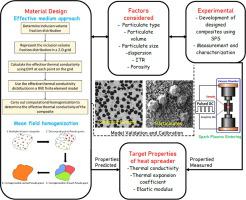Engineering Science and Technology, an International Journal ( IF 5.7 ) Pub Date : 2021-06-16 , DOI: 10.1016/j.jestch.2021.05.023 Syed Sohail Akhtar

|
A computational framework built on an effective-medium theory and mean-field homogenization is used to design particulate copper (Cu) composite for high-performance heat spreaders for electronic devices. Several potential particulate types as a second-phase are considered based on their intrinsic properties to design various Cu-composite heat-spreaders leading to desirable properties such as low coefficient of thermal expansion (CTE), low density, and improved structural response without compromising on required thermal conductivity. Based on computational predictions, the thermal interface of matrix-particulate is found to be the dominant factor for maintaining required thermal conductivity (~300 W m−1 K−1), which suggested ceramic particles, particularly Beo, SiC, and AlN, as preferred candidates when loaded up to 30 vol%. Due to very high thermal conductivity and low CTE, diamond particles demonstrated the best results provided its wettability with copper is improved as a result of the surface coating. To validate the model results, numerous Cu composites with diamond as a second-phase are sintered using the spark plasma sintering technique, and the experimental data is found in close agreement with the predictions. The Cu composites containing Ni-coated diamond particles exhibited thermal conductivity more than the value of pure Cu at extremely low volume concentration (5%). The effect of particle size is also studied and it is found that the composites sintered with sub-micron particles resulted in more porosity as compared to micron-sized particles, which displayed direct bearing on thermal and mechanical properties as demonstrated by experimental data. The measured data on densification and particle–matrix interface condition is used in calibrating the models for establishing their effect on resulting thermal and structural properties. The presented integrated computational design methodology is validated using experimental data, which is expected to help the researchers and electronic industry develop high-performance heat spreaders with tailored properties.
中文翻译:

开发高性能烧结颗粒铜复合材料作为散热器材料的系统设计
基于有效介质理论和平均场均匀化的计算框架用于设计用于电子设备的高性能散热器的微粒铜 (Cu) 复合材料。根据其固有特性,考虑了几种潜在的颗粒类型作为第二相,以设计各种铜复合散热器,从而获得所需的特性,例如低热膨胀系数 (CTE)、低密度和改善的结构响应,而不会影响所需的热导率。根据计算预测,发现基质-颗粒的热界面是维持所需热导率 (~300 W m -1 K -1),这表明陶瓷颗粒,特别是 Beo、SiC 和 AlN,当负载量高达 30 vol% 时是首选的候选材料。由于非常高的热导率和低 CTE,金刚石颗粒表现出最好的结果,前提是其与铜的润湿性由于表面涂层而得到改善。为了验证模型结果,使用放电等离子烧结技术烧结了大量以金刚石为第二相的 Cu 复合材料,实验数据与预测非常吻合。含有镀镍金刚石颗粒的铜复合材料在极低的体积浓度(5%)下表现出高于纯铜的热导率值。还研究了粒度的影响,发现与微米级颗粒相比,用亚微米级颗粒烧结的复合材料会产生更多的孔隙率,这与实验数据表明的热性能和机械性能有直接关系。关于致密化和颗粒-基质界面条件的测量数据用于校准模型,以确定它们对所得热和结构特性的影响。所提出的集成计算设计方法使用实验数据进行了验证,有望帮助研究人员和电子行业开发具有定制特性的高性能散热器。关于致密化和颗粒-基质界面条件的测量数据用于校准模型,以确定它们对所得热和结构特性的影响。所提出的集成计算设计方法使用实验数据进行了验证,有望帮助研究人员和电子行业开发具有定制特性的高性能散热器。关于致密化和颗粒-基质界面条件的测量数据用于校准模型,以确定它们对所得热和结构特性的影响。所提出的集成计算设计方法使用实验数据进行了验证,有望帮助研究人员和电子行业开发具有定制特性的高性能散热器。


























 京公网安备 11010802027423号
京公网安备 11010802027423号